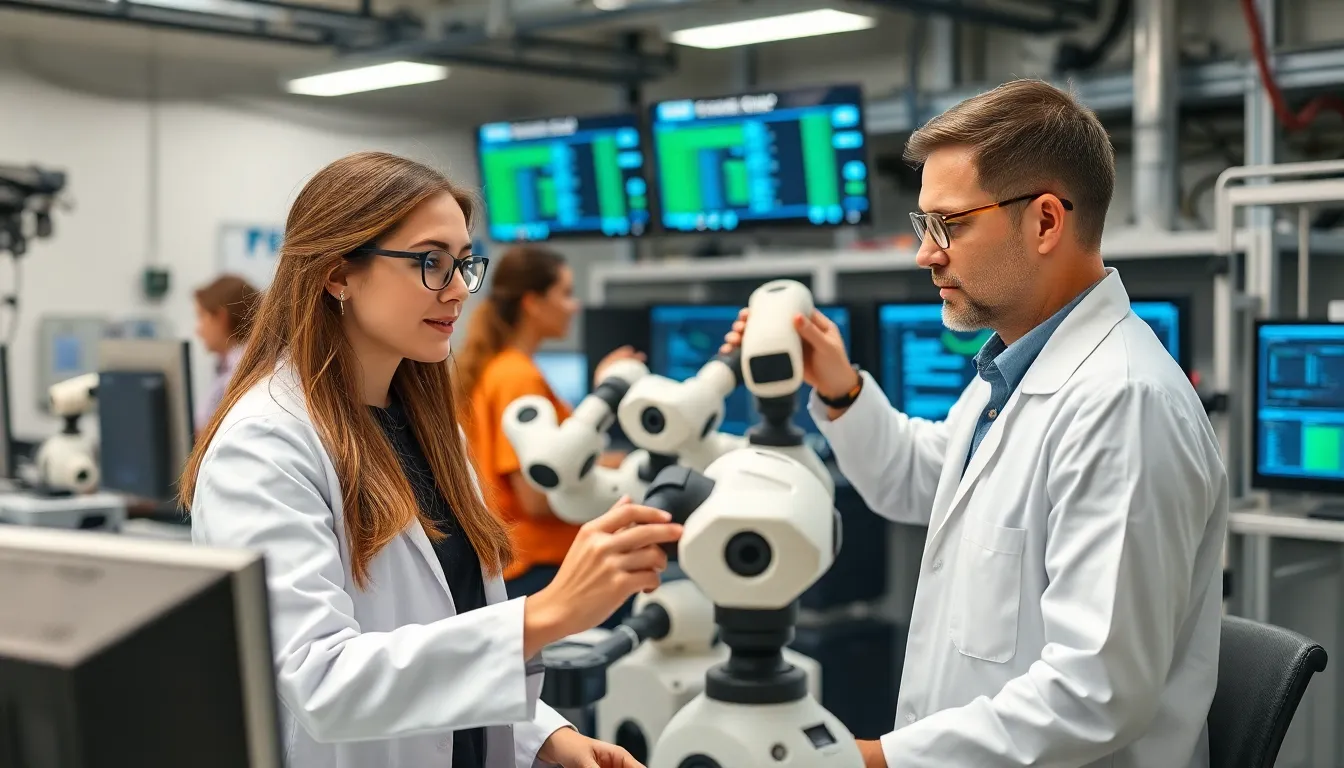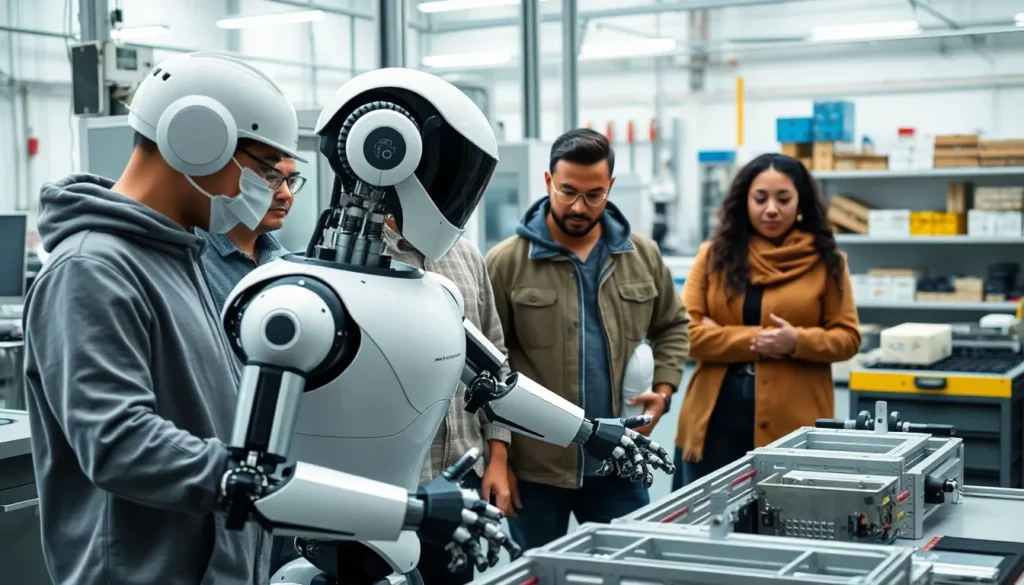Table of Contents
ToggleIn a world where robots are no longer just the stuff of sci-fi movies, tech-driven robotics solutions are revolutionizing industries faster than you can say “artificial intelligence.” From manufacturing to healthcare, these mechanical marvels are stepping in to tackle tasks that would make even the most seasoned professionals sweat. Imagine a robot that can assemble your furniture without losing a screw—now that’s a game changer!
But it’s not just about efficiency; it’s also about innovation. As technology evolves, so do the capabilities of these robots. They’re becoming smarter, faster, and maybe just a tad sassier. With the power of AI and machine learning, today’s robots can adapt to new challenges and even learn from their mistakes—something we humans could certainly use a lesson in! Dive into the world of tech-driven robotics solutions and discover how they’re reshaping the future, one circuit at a time.
Overview of Tech-Driven Robotics Solutions
Tech-driven robotics solutions integrate advanced technologies to revolutionize operations in multiple sectors. These solutions utilize artificial intelligence, machine learning, and sensor technologies, enabling robots to conduct intricate tasks with high efficiency. Factories employ automation robots to streamline production lines, significantly reducing operational costs by 20-30%.
Healthcare benefits from robotic surgical systems that enhance precision and minimize recovery times. Logistics companies implement autonomous drones for inventory management, leading to faster delivery times and better tracking of goods. Agriculture increasingly relies on robotics such as harvesters and drones, improving crop yield by approximately 15%.
Every advancement in robotics contributes to enhanced adaptability. Algorithms allow robots to learn from their environments, leading to continuous improvement in performance. These intelligent systems make decisions based on real-time data, which elevates their operational effectiveness.
Furthermore, collaborative robots, also known as cobots, work alongside human employees, supporting tasks that require strength or precision. The interplay between humans and robots fosters a safer work environment and improves overall workplace productivity by 10-20%.
Tech-driven robotics solutions are redefining the human-robot relationship within workplaces, allowing for enhanced collaboration. Their deployment not only transforms industry standards but also sets the stage for innovative solutions that continue to emerge. As technology progresses, the future of work becomes increasingly intertwined with robotics.
Key Technologies Driving Robotics

Robotics technology continuously evolves through innovations that enhance performance and efficiency. Specific technologies play pivotal roles in this transformation.
Artificial Intelligence in Robotics
AI enhances robotic capabilities significantly. It enables robots to analyze complex data and make informed decisions quickly. Robot behavior adapts through AI, allowing for improvements in tasks such as navigation and object recognition. Industries leverage AI-driven robots for specific purposes, enhancing productivity across various sectors. For example, autonomous vehicles utilize AI algorithms to interpret their surroundings, ensuring safer operation. Ultimately, AI’s impact on robotics advances both precision and automation.
Machine Learning Applications
Machine learning transforms how robots interact with their environments. Robots equipped with machine learning algorithms learn from experiences, improving their performance over time. Training on extensive datasets allows these machines to optimize decision-making processes. For instance, warehouse robots use machine learning to enhance inventory management by predicting stock levels and adjusting their actions accordingly. Businesses implement machine learning in robotics to streamline operations and reduce costs.
Internet of Things (IoT) Integration
IoT integration offers unprecedented connectivity for robotic systems. Robots equipped with IoT technologies communicate with other devices, sharing real-time data that enhances functionality. Data from sensors informs robots of environmental changes, enabling quick adjustment to tasks. For example, smart agricultural drones collect data on crop conditions, improving efficiency and yield. The synergy between IoT and robotics opens pathways for advanced automation across various industries, fostering innovation.
Applications of Tech-Driven Robotics Solutions
Tech-driven robotics solutions impact various sectors, allowing for increased efficiency and operational flexibility. These applications demonstrate the breadth of robotics across industries.
Industrial Automation
Robotics revolutionizes industrial automation, boosting productivity on factory floors. Automation robots streamline production lines, achieving operational costs reductions of 20-30%. These machines perform repetitive tasks, reducing human error and increasing output consistency. Advanced robots can integrate with AI systems, monitoring their own performance and suggesting improvements. Companies using robotics in assembly processes experience faster turnaround times, as these solutions adapt to changing production demands.
Healthcare Advancements
In healthcare, robotic surgical systems enhance precision and minimize recovery times. Surgical robots assist in complex procedures, allowing for minimally invasive techniques. These advancements reduce patient stress and shorten hospital stays by days. Robots also aid in routine tasks, such as medication delivery, improving overall hospital efficiency. AI-driven diagnostics enhance treatment accuracy, empowering healthcare providers to make informed decisions quickly.
Consumer Products
Robotics also plays a vital role in consumer products, transforming the way items are designed and manufactured. Automated production lines enable mass customization, allowing brands to meet specific consumer demands efficiently. Robotics aids in quality control, ensuring products meet standards through real-time inspection. Smart home devices utilize robotics to provide personalized user experiences, responding to individual preferences. As technology evolves, consumers can expect more intelligent interactions with their products.
Challenges and Limitations
Tech-driven robotics solutions face various challenges and limitations that impact their implementation and efficiency. High initial costs often deter companies from adopting these advanced systems. Investing in robotics requires significant financial resources for not only the robots but also infrastructure updates.
Integration with existing systems presents another hurdle. Businesses may struggle to adapt their traditional processes to accommodate new robotic technologies. Consequently, this results in potential disruptions during the transition period, affecting overall productivity.
Robotics solutions also encounter limitations in flexibility. Many robots today are designed for specific tasks and require extensive reprogramming for other applications. Robotics in manufacturing, for example, may not easily shift from assembling one product to another without additional customization.
Skill gaps among the workforce pose a major obstacle as well. The demand for engineers and technicians who can design, maintain, and program these systems remains high. Companies may find it difficult to fill these positions, leading to a reliance on external consultants or ongoing training programs.
Regulatory constraints can inhibit robotics deployment in various sectors. Compliance with safety regulations and standards requires businesses to navigate complex legal landscapes, slowing down implementation timelines. This can complicate the integration of autonomous drones in logistics, for instance, due to varying state and federal regulations.
Another factor involves concerns over job displacement. Increased automation brings fears of workforce reduction, creating resistance against adopting robotics solutions. Employment levels in sectors like manufacturing often fluctuate in response to technological advancements.
Despite these challenges, addressing limitations can foster innovation and drive solutions. Developing adaptable robots, improving workforce training, and streamlining regulatory processes contribute to more successful integration in the future.
Future Trends in Robotics Technology
Advancements in robotics technology indicate a significant shift toward greater automation. Current trends emphasize collaborative robots, known as cobots, which enhance human-robot cooperation. Integration of artificial intelligence is making these cobots more intuitive, allowing them to assist workers efficiently in various environments.
Emerging robotics solutions also leverage machine learning for improved adaptive capabilities. As robots learn from experiences, they fine-tune their operations, optimizing tasks like inventory management. Industry experts report that this adaptability could increase productivity in logistics by up to 30%.
The Internet of Things plays a crucial role in connecting robotic systems. IoT-enabled robots gather and analyze real-time data, enabling quicker decision-making within manufacturing and healthcare settings. Such connectivity enhances operational efficiency and promotes seamless automation.
Autonomous vehicles represent another prominent trend in robotics. Companies are investing heavily in this technology, with predictions suggesting a growth rate of 25% annually in the sector. This trend extends beyond traditional transportation, influencing sectors like agriculture where autonomous drones manage crop monitoring and treatment.
Healthcare robotics continues to evolve, with innovations in surgical systems improving patient outcomes. Predictions indicate a significant reduction in recovery times as robotic assistance becomes more prevalent during operations. Furthermore, telemedicine robots facilitate remote consultations, expanding patient access to care.
Challenges persist amid this progress, particularly in addressing skill gaps and regulatory hurdles. Training initiatives are vital for developing a workforce capable of managing advanced robotics. Moreover, ongoing dialogue with regulatory bodies is necessary to create frameworks that support safe and effective deployment of these technologies.
Tech-driven robotics solutions are reshaping industries by enhancing efficiency and productivity. As these technologies continue to evolve through advancements in AI and machine learning, their ability to adapt and learn will further revolutionize operations. The integration of IoT fosters seamless connectivity, allowing robots to respond to real-time data and collaborate effectively with human workers.
While challenges like high initial costs and workforce skill gaps remain, the potential for innovation is immense. Companies that embrace these solutions can expect significant improvements in their operations and a competitive edge in the market. As the landscape of robotics continues to change, ongoing investment in training and infrastructure will be crucial for harnessing the full benefits of this technological revolution.




